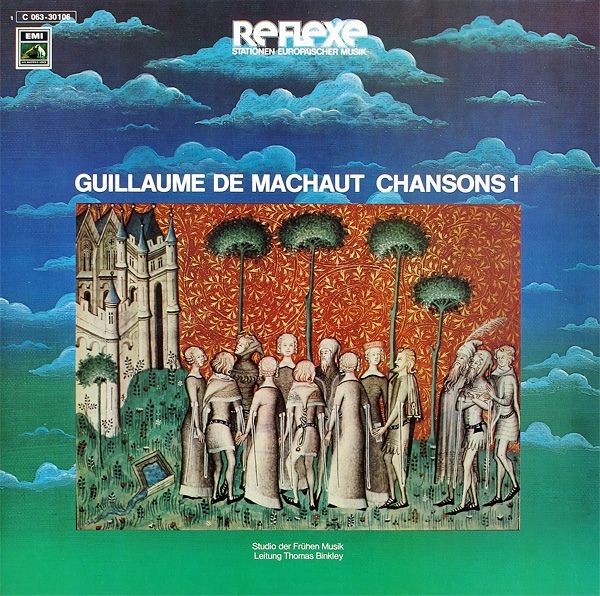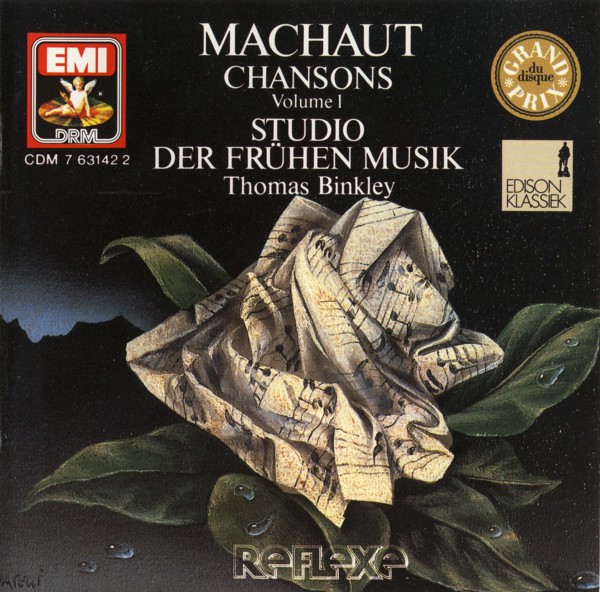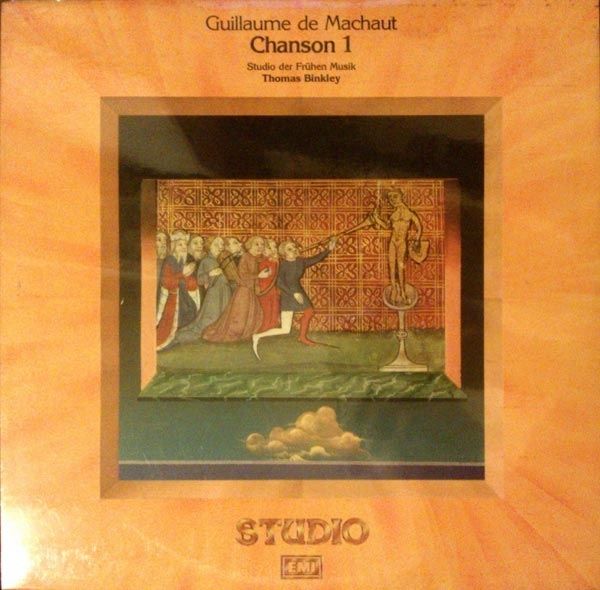
medieval.org
LP, 1972: EMI Reflexe 1C 063-30106
CD, 1989: EMI CDM 7 63142 2

medieval.org
LP, 1972: EMI Reflexe 1C 063-30106
CD, 1989: EMI CDM 7 63142 2
1. Ay Mi! [3:13]
Virelais | Altus, Lira, Laute, Harfe, Glockenspiel
2. Loyauté, que point ne delay [6:44]
Lais | Mezzosopran, Laute
3. Comment qu'a moy lonteinne [3:07]
Virelais | Altus, Organetto, Laute, Harfe
4. Quant je sui mis au retour [1:37]
Ballade, Trouvere contrafactum | 3 Solostimmen, Chor
5. Joie, plaisence, et douce norriture [6:08]
Chanson royale | Altus, Fiedel
6. Tels rit au matin [8:45]
Complainte | Mezzosopran, Fiedel, Laute
7. Dame, a voussans retollir [2:56]
Virelais | Mezzosopran, Chor, Tambourin
LE LAY DE LA FONTEINNE
8. I. Je ne cesse de prier [1:52]
Mezzosopran, Laute
9. II. Et ou porrait on querir [1:51]
Dreistimmiger Kanon
10. III. C'est celle qui par ordonnance [3:10]
Mezzosopran, Laute
11. IV. Ce trois-un a po de peinne [1:49]
Dreistimmiger Kanon
12. V. Et qui de ceste eaue prendroit [2:04]
Mezzosopran, Laute
13. VI. Mais ceste trinite [2:06]
Dreistimmiger Kanon
14. VII. De la duis le pere nomme [2:07]
Mezzosopran, Laute
15. VIII. Et pour ce dique cil troy [1:54]
Dreistimmiger Kanon
16. IX. Pour ce te pri [1:10]
Mezzosopran, Laute
17. X. Mais de tel confort [2:02]
Dreistimmiger Kanon
18. XI. He! fonteinne de concorde [2:16]
Mezzosopran, Laute
19. XII. Pour laver et nettoier [1:45]
Dreistimmiger Kanon

STUDIO DER FRÜHEN MUSIK
GUILLAUME DE MACHAUT Thomas Binkley, 1972
Thomas Binkley
Andrea von Ramm, Mezzosopran, Harfe
Richard Levitt, Altus, Glockenspiel
Sterling Jones, Fidel, Lira, Organetto
Thomas Binkley, Laute, Tamburin
unter Mitwirkung von:
Dominique
Bello, Patricia Calamaro, Marie-Paule Canonia, Jacqueline Grieb, Tania
Kestinsky, Jacqueline Magro, Said Saida, Denis Vial,
Chor
(Einstudierung: Madame Fauré)
[CD]:
Ⓟ 1972 EMI Electrola GmbH
Digital reamastering Ⓟ 1989 by EMI Electrola GmbH
© 1989 by EMI Electrola GmbH
Aufgenommen: IX.1971, St. Victor, Marseille
Produzent: Gerd Berg
Tonmeister: Johann Nikolaus Matthes
Titelseite: Roberto Patelli

There can be little doubt that Guillaume de
Machaut is the best-known composer of the 14th century. His complete
poetical and musical works have been before us in scholarly editions for
several generations; how surprising then to find he is so little
understood.
The renaissance of Machaut was perhaps premature. He
became widely known as the composer of the earliest complete polyphonic
setting of the ordinary of the mass; this mass has been published and
recorded many times. Yet it remains a peripheral work neither typical of
his writing nor central to his musical thinking. Machaut is often
lauded as the composer of songs displaying clever erudite techniques
(e.g. "My end is my beginning"). He is praised as the earliest composer
to write many polyphonic songs. His motets are sometimes mentioned, as
is his David Hocket, a singular work and, like the mass, not
particularly relevant to his genius. Being the first or last to do
anything is no measure of greatness. Machaut's monophonic music is
seldom discussed and still less often performed. Yet it was one of his
favourite areas of work, and clearly reveals essential features of his
art.
We must recognize that Machaut was a songwriter whose great
breadth of genius, spanning areas of experimentation and areas of
tradition, nearly always brings three things into focus: text, music and
structure. He was a master craftsman in dealing with his words and
music, and a balanced perception of his contribution requires an
understanding of his work, in the area of monophony and of polyphony;
for in spite of everything, polyphonic song is not simply monophonic
song with the addition of accompanying parts (his correspondence with
Perronne, seemingly to the contrary, notwithstanding). A careful look at
his melodies reveals a different approach to melodic writing as between
these contrasting techniques, in the use of rests and leaps, and more
particularly in affect.
We have selected for this recording
monophonic works that reflect the broad spectrum of his monophonic
composition. How different and how remarkable are these works! What an
array of forms: planctus, cantus coronatus, lai and virelai. Needless to
say, the texts are of high literary quality: not indulgently expressive
in the manner of a Byron, for Machaut addressed himself to a courtly
French audience possessing the sensitivity required to appreciate his
spectacular virtuosity, through which words served functions of imagery
and structure as well. With a word, he can create or shatter an
ambience, he can delight and move. When he brings his texts into music,
they are set off with a touch of objectivity that results from absolute
control of all structural details.
Some sense of his structures he has imparted in the Remède de fortune,
an intriguing if rambling poetical work containing seven musical
illustrations. Three of these are included here, and we have provided
just a snatch of his verse before each of the three pieces, so as to
offer the listener the opportunity of hearing the sound of his language
and his poetry. The several spoken lines are not part of the music of
course, but an introduction.
It is perhaps questionable to
suggest that a piece of music requires any introduction, yet I feel the
hurried listener will appreciate a word about the pieces. Of the fountain
is a lai of about average length for Machaut. It consists of twelve
sections alternating, as I believe was his intention, between solo and
chorus. The chorus sections, marked chasse, are written as
three-part canons (and form the most intriguing canons of the 14th
century). Even the solo sections are so designed to permit canonic
performance, an observation which has been taken into consideration in
the shaping of the accompaniments. As is customary with Machaut's lais,
the final section is like the opening section but transposed down a
fourth.
This is not true of one lai by Machaut, Loyauté.
In this piece there are only two sections of music; they serve two
poetic structures which alternate in an irregular pattern of pairs. A
followed by B or A and B followed B or A. There are twelve such pairs,
but we found it necessary to cut part of the text in order to fit it on
this record; we feel the essence of the piece and its structure rest
intact.
The text of another piece is also cut, the planctus Tel rit, which with its 36 strophes would fill a whole record by itself. This striking melody, so clearly a complainte,
must be included even if it means shortening it by many strophes. The
recitation of some strophes follows the documented practice of the 13th
and 14th centuries of reciting the texts of songs in conjunction with
the musical performance of them. There is no polyphonic form even
vaguely similar to the complainte, although in the virelais we
find both polyphonic and monophonic examples. They are similar in both
length and style (after all they are virelais) for Machaut was careful
to relate subject matter with structure and style. This relationship is
not a matter of word-note correlation, but consists of a much more
abstract and subtle suggestiveness.
The chanson royale Joie plaisence,
which we hold to be the sort of song Grocheo called cantus coronatus
because of the structure of the melody, is written to make possible the
ornaments described by Grocheo (which the above-mentioned complainte
cannot accommodate). The accompaniments are our own, following a
principle unstated but undeniable: each instrument through its own
characteristics places its peculiar stamp on the accompaniment, which
thus develops out of the playing technique of the instrument rather than
the rules of counterpoint. The neuma or instrumental tails which
conclude some of the pieces, on the other hand, are taken from
Grocheo's list and are related only to the mode of the melody. Grocheo,
writing in Paris about 1300, is no contemporary of Machaut's, but it is
difficult to imagine any pertinent changes in this area.
The
instruments employed are those of Machaut's time and place. He mentioned
them all many times, along with dozens more. But alas there is not time
on a single disc to bring in the wealth of 14th-century French
instruments, and thus we have kept the number to a minimum so that the
concentration is upon Machaut's genius rather than on the colourful
instruments of his time. Voices are instruments too, of course, and we
have taken cognizance of the head, throat and chest voices discussed by
the theorists of the time. Also, we invited some young girls from
Marseilles to sing with us (which is one reason why we made the
recording there). We feel Machaut would have liked that idea, and the
listener will be grateful for the timeless sound of these French voices.
Another
reason for selecting Marseilles was the ancient abbey of St Victor on
the hill overlooking the bay. Machaut must have known the abbey: he may
have visited it on his way to Cyprus, and St Victor, quite apart from
Machaut, has secured for itself an important place in still earlier
music history. We set up the microphones in the humid crypt a few yards
from where recent excavations uncovered 5th-century Christian-Roman
stonework and not much further from the entrance to a secret passageway
running beneath the sea across to the other side of the bay. The
ambience was most rewarding — a far cry from modern studios — with the
result that the whole project was completed in a very short time.
